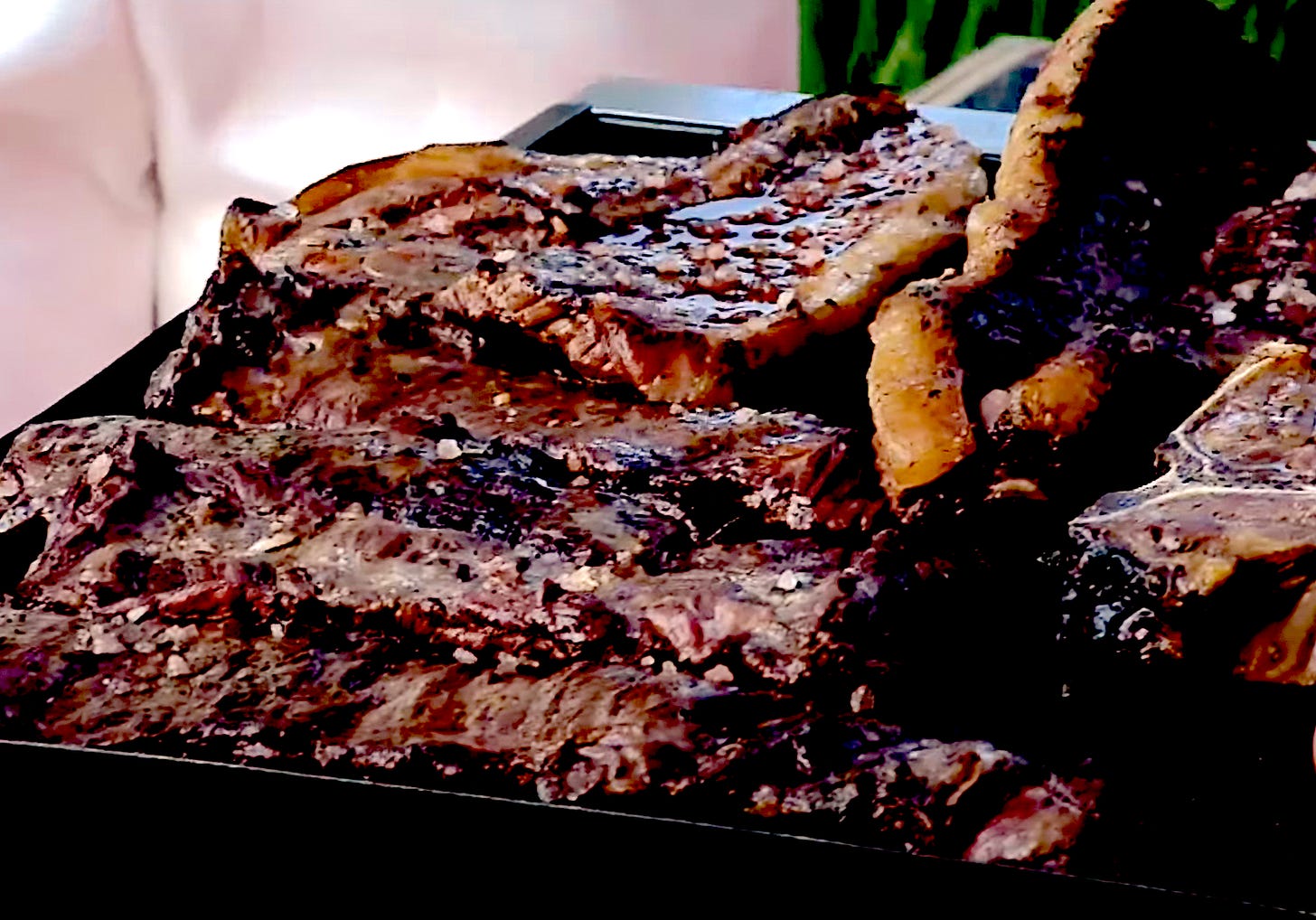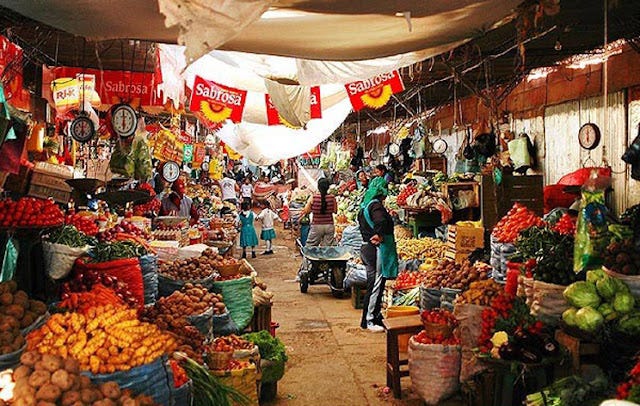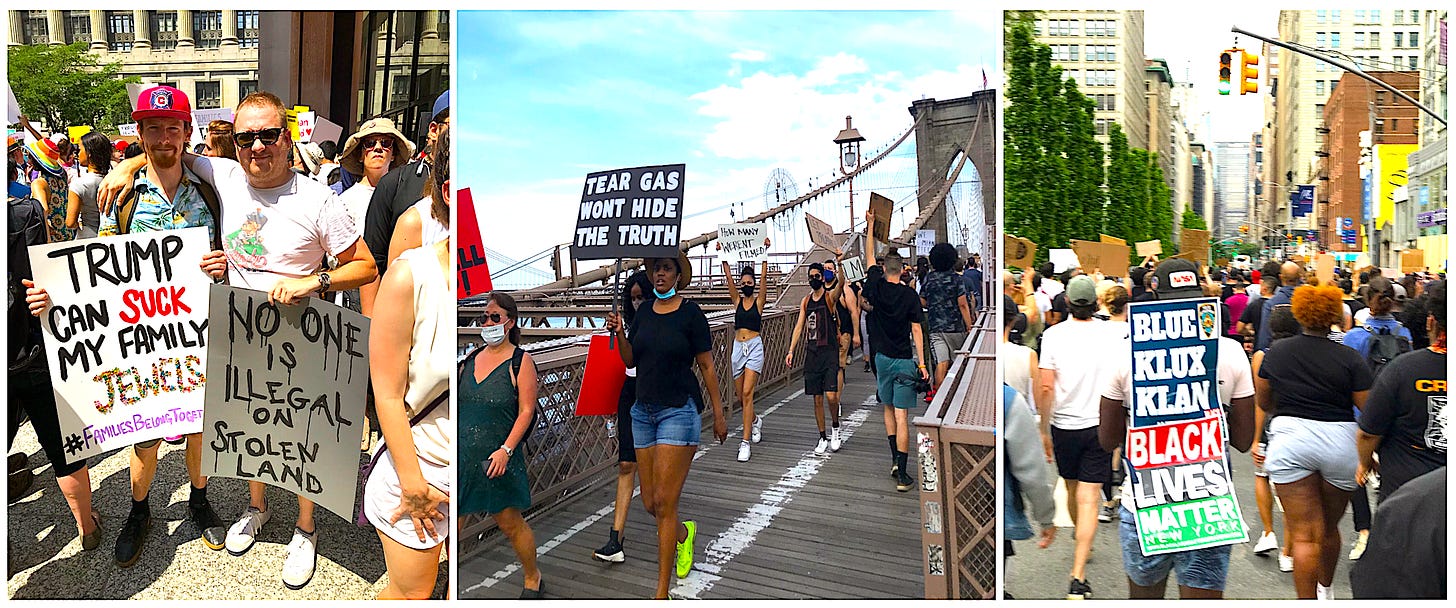Notable Sandwiches #46: Churrasco
Red meat for the masses, or to feed a revolutionary awakening
Welcome back to Notable Sandwiches, the series in which I, alongside my editor David Swanson, stumble through the strange and ever-shifting document that is Wikipedia’s List of Notable Sandwiches, in alphabetical order. This week: David addresses the churrasco, and his political awakening in Bolivia at the turn of the century. (To new subscribers: David Swanson and I sometimes alternate sandwich essays!)
The year 2000 was a fortuitous time to find oneself in Cochabamba, a city of 600,000 situated 8,000 feet high in the Bolivian Andes. But that would only become clear gradually. At the time, I was just out of college, with expectations as elevated as the surroundings. A year before, my maternal grandfather had died at the age of 98, leaving a generous little endowment—enough to buy a car, or pay off some loans, or to save for a rainy day. I decided to use it to see a bit more of the world. My grandfather—Col. John Alfred Burden, MD, born in Tokyo in 1900—was as global a citizen as I knew, and this seemed like a fitting tribute.
I’d spent the Fall of 1999 in Nepal, one of the few places in the world that can match the mystical, thrilling beauty of Bolivia. Now I was experiencing second surfeit of wonder and of heartbreak: the mighty peaks ringing the verdant Cochabamba Valley; the preserved fetal llamas, sold at roadside stalls to help ward off espíritus malignos; the homeless children begging on the streets. But what distinguished Bolivia for me was not the staggering natural beauty, the fascinating folkways, or the abject human desperation—though all three were apparent in abundance. No, what most sticks out over two decades later (other than amazing kids I got to know at the Villa Amistad orphanage, where I was volunteering) are my personal political awakening, and the truly obscene amount of churrasco I consumed.
There could be a whole sub-section of this series just focusing on South American beef sandwiches. Which is logical: any comprehensive Venn diagram of Latin American obsessions would need to accommodate vectors for both “beef” and “sandwiches.” In her fascinating histories of the beirute and the chacarero, Talia detailed the strange vicissitudes of the Columbian interchange, and this almost gravitational attraction to red meat—as a business, as source of nourishment, as an identity. The Latin flair for the sandwich arts was similarly addressed over the summer, in columns on the butifarra, the cemita. and los barros jarpa y luco. Last month’s essays on the chivito and choripan delved further into this cultural passion for fire-grilled protein.
Wikipedia lists the churrasco as a Chilean sandwich—“thinly cut steak, grilled and served on a toasted bun”—but the link leads to a page on the churrasco more generally, and that’s the dish I’m here to discuss. In Brazil, where churrasco culture was born, the name connotes various cuts of grilled beef: picanha, top sirloin folded into a C-shape and seasoned with garlic or sea salt; the long, flat fraldinha, with its heavy marbling; filé mignon, grilled plain, wrapped in bacon, or crusted in Parmesan; chuleta, whole cuts of skewered ribeye. In Cochabamba, you could sample all of these at one of the city’s Brazilian-style rodízios, but those required a bankroll thicker than mine. The churrascos I came to rely on were usually grass-fed skirt steaks, seasoned with nothing but salt and their own rendered fat.
Whatever I was looking for in those youthful, heady days, it wasn’t sandwiches. But the smell of sizzling beef—grilled over glowing embers, dutifully manned by a cheerful Andean proprietor—is a memory that lingers. Luckily, everywhere I went in Cochabamba, that scent was never far away. For just a few American dollars I could buy myself a plate-sized steak straight off the ripping-hot parilla, along with a cold cerveza, some potatoes, rice, and maybe a few vegetables. This wasn’t a sandwich, but it was churrasco, and it would be my diet for the next six months.
The Sword and the Sandwich is a newsletter about serious extremism and equally serious sandwiches. Please consider supporting this work with a paid subscription:
When I wasn’t working at the orphanage, or studying Spanish at the Maryknoll Institute, I explored Cochabamba on foot and on bicycle. The soundtrack to my Discman-enhanced excursions was limited to the early Stones, Beasties Boys, and Shakira, who I’d never before encountered, but whose Latino-con-Laventino rhythms were pouring out of every open doorway. When I arrived it was January—Bolivian midsummer—and even though Cochabamba is closer to the equator than Mumbai or Harare, the altitude keeps things cool and spring-like all year round. Unlike in Nepal, where I had befriended a number of locals my age, in Cochabamba I had no real social life. I was boarding with a prim, white, middle-class family on the outskirts of the city, knew only a smattering of Spanish, and only a handful of American expats. I was trying (in my own way) to figure out what I should do with my life, armed with a masters degree in modern history, and not much else.
Between Nepal and Bolivia, this ersatz gap year was my Anthropocene awakening after a lifetime cosseted in middle-class privilege. I read a ton—Garcia Marquez and Norman Mailer, Dostoyevsky and Toni Morrison. I explored every inch of Cochabamba itself, with side trips to the depths of Amazon and the heights of the Altiplano. I ate all sorts of new things: porcine capybara in the lush Llanos region; delectable anticuchos—skewers of sliced grilled beef heart—served by late-night vendors at busy crossroads; sweet and savory salteñas everywhere. But I was also a fundamentally ignorant 22-year-old American male, and the prospect of cheap, plentiful grass-fed beef was not one I was going to let pass me by. I may not have eaten churrasco every day, but I came close.
My favorite spots were inevitably somewhere I’d stumbled upon in the tangled bowels of La Cancha, after an exhausting day of urban exploration. If Cochabamba is the gastronomic capital of Bolivia, La Cancha is its breadbasket. The heart of city, and the largest open-air market in the Americas, its fifteen-square city blocks teem with merchants, vendors, farmers, and craftspeople selling mountains of fresh produce and baby shoes and flat-screen TVs and technicolor Andean textiles and dried coca leaves by the bale. It was colorful and generous and overwhelming, and it was soon to be engulfed in utter, tragic turmoil.
“The Water War began in earnest in February, 2000,” wrote William Finnegan in the New Yorker two years later. “Crowds of regantes—peasant irrigators—arrived in the city, marching under village banners, or wiphala. The women, cholitas, wore fine straw hats and shimmering pleated velvet dresses, and their black hair was braided in long pigtails woven together in back with bright ribbons.” At the beginning of my stay, in January, there had been rumblings of discontent concerning the recent privatization of the city’s water supply, and how that might affect the local populace. Over the course of several weeks, as I got to know the city better and as my Spanish improved, those rumblings grew to a din.
The “Cochabamba Water Wars” started with a smattering of protests and strikes. Soon, barricades appeared on major thoroughfares throughout the city, obstacles I could negotiate on foot or on my bicycle, but which made car travel nearly impossible, and complicated my commute to the orphanage. I kept having to replace my tires because of the scattered nails and broken glass carpeting the roads—which seemed like a big deal until I remembered the nearly two hundred protesters arrested, and the seventy civilians wounded by federal authorities.
The Bolivian government had granted a monopoly on Cochabamba’s water to a private Bechtel-owned consortium, Aguas del Tunari, offering a $2.5-billion, 40-year contract; upon taking control, the company raised water prices drastically. The protesters, led by union firebrand Óscar Olivera, grew to include teachers, students, homeless street urchins, teenage anarchists and pieceworkers, miners and sweatshop employees—a mass movement whose general strikes and protests shut the city down for days at a time. But not without a human cost: in April, Víctor Hugo Daza, a seventeen-year-old student walking home through the central plaza, was shot dead by a Bolivian Army captain on live television.
By Easter, the government had declared “a national state of siege”; major highways were blockaded, and the protests spilled over to Oruru, Achacachi, La Paz. While my white Bolivian host family urged me to keep my distance from the unfolding violence, I soon joined the mostly Indigenous protesters, a bandanna soaked in vinegar and baking soda wrapped around my face to help protect me from tear gas. That’s the second aroma that Cochabamba evokes for me, and with it the thrilling promise of direct political action.
Those days amidst the tumult of Cochabamba exhilarated me, awakening a heretofore dormant activist gene. I had bemoaned how apolitical my teenage years in Bill Clinton’s America always felt, especially compared to my father’s stories of battling National Guard troops in Madison, Wisconsin, during anti-war demonstrations in the sixties. It helped that the Water War had an almost surreal, triumphant ending: the executives of the would-be monopolist consortium fled the country, and the law enforcing the contract was repealed. Labor leader Óscar Olivera summed it up that month: “The people have recaptured their dignity, their capacity to organize themselves—and most important of all, the people are no longer scared.”
I was too young to know how young I was, on the precipice of a new millennium, and the world seemed pregnant with possibility. By the time I left Bolivia that summer, I had decided to pursue a career in journalism. That fall, I interned at Rolling Stone magazine, where I watched the culmination of the 2000 presidential election, as the American political system I had always revered was proven to be as corrupt as any South American caudillo, and my newly chosen profession, unbeknownst to me, began its slow slide into decades of decline.
While there was no tear gas or pepper spray in those years, there was still beef, ever-present, always tantalizing. Just a few blocks from my Lower East Side apartment, I discovered an Argentine restaurant where I could get a reasonable facsimile of the churrasco I’d grown to love in Bolivia. With a beer, it probably cost five times as much as what I had paid in Cochabamba, but the meat had that familiar grassy tang and salty char. I probably ate there more often than an assistant editor’s salary could justify, but at that point I was addicted.
Though the familiar aroma of grilled beef has never again been far from my life, the same cannot be said for that secondary olfactory cue. In the ensuing years, I’ve marched and protested for immigrant families and for Black Lives and Women’s Rights and against police overreach and Wall Street avarice. But there have been no more encounters with those choking clouds of vaporized oppression I knew from Cochabamba. Still, I treasure the sense of purpose and promise that accompanied that smell, and which has returned in recent years, as the foundation of American democracy has become increasingly wobbly. The Water War marked my churrasco-fueled transition to adulthood, and its lessons cling to me like tear gas to cotton, like the enduring clash between greed and good, like salt clinging to meat, and the tongue and the mind remember.











This is such a wonderfully evocative piece!